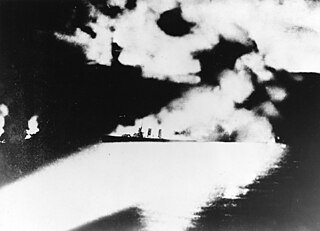
The Battle of Savo Island, also known as the First Battle of Savo Island and in Japanese sources as the First Battle of the Solomon Sea, and colloquially among Allied Guadalcanal veterans as the Battle of the Five Sitting Ducks, was a naval battle of the Solomon Islands campaign of the Pacific War of World War II between the Imperial Japanese Navy and Allied naval forces. The battle took place on 8–9 August 1942 and was the first major naval engagement of the Guadalcanal campaign and the first of several naval battles in the straits later named Ironbottom Sound, near the island of Guadalcanal.
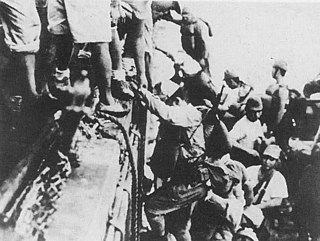
The Tokyo Express was the name given by Allied forces to the use of Imperial Japanese Navy ships at night to deliver personnel, supplies, and equipment to Japanese forces operating in and around New Guinea and the Solomon Islands during the Pacific campaign of World War II. The operation involved loading personnel or supplies aboard fast warships, later submarines, and using the warships' speed to deliver the personnel or supplies to the desired location and return to the originating base all within one night so Allied aircraft could not intercept them by day.

The Battle of Tassafaronga, sometimes referred to as the Fourth Battle of Savo Island or in Japanese sources as the Battle of Lunga Point, was a nighttime naval battle that took place on 30 November 1942 between United States Navy and Imperial Japanese Navy warships during the Guadalcanal campaign. The battle took place in Ironbottom Sound near Tassafaronga Point on Guadalcanal.

"Ironbottom Sound" is the name given by Allied sailors to the stretch of water at the southern end of The Slot between Guadalcanal, Savo Island, and Florida Island of the Solomon Islands, because of the dozens of ships and planes that sank there during the naval actions comprising the Battle of Guadalcanal during 1942–1943. Before the war, it was called Savo Sound. Every year on the battle's anniversary, a US ship cruises into the waters and drops a wreath to commemorate the men who lost their lives. For many Navy sailors, and those who served in the area during that time, the waters in this area are considered sacred, and strict silence is observed as ships cruise through.

USS Northampton (CL/CA-26) was the lead ship in Northampton-class cruiser, in service with the United States Navy. She was commissioned in 1930, originally classified a light cruiser because of her thin armor but later reclassified a heavy cruiser because of her 8-inch guns. During World War II she served in the Pacific and was sunk by Japanese torpedoes during the Battle of Tassafaronga on 30 November 1942. She was named after the city of Northampton, Massachusetts, the home of former President Calvin Coolidge.

USS Minneapolis (CL/CA-36) was a New Orleans-class cruiser built for the United States Navy before the outbreak of World War II, the second ship named for Minneapolis, Minnesota. She served in the Pacific Theater during World War II.

USS Aaron Ward (DD-483) was a Gleaves-class destroyer in the service of the United States Navy. She was the second Navy ship named in honor of Rear Admiral Aaron Ward. She sank on 7 April 1943 in a shoal near Tinete Point of Nggela Sule, Solomon Islands during Operation I-Go. Her wreck was discovered on 4 September 1994.

The Battle of Cape Esperance, also known as the Second Battle of Savo Island and in Japanese sources as the Sea Battle of Savo Island (サボ島沖海戦), took place on 11–12 October 1942, in the Pacific campaign of World War II between the Imperial Japanese Navy and United States Navy. The naval battle was the second of four major surface engagements during the Guadalcanal campaign and took place at the entrance to the strait between Savo Island and Guadalcanal in the Solomon Islands. Cape Esperance (9°15′S159°42′E) is the northernmost point on Guadalcanal, and the battle took its name from this point.
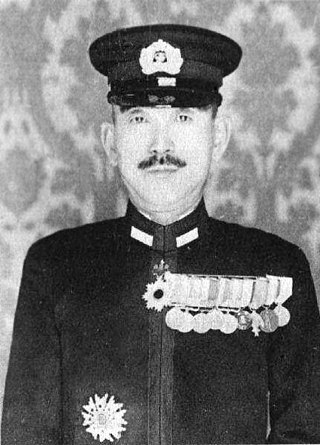
Raizō Tanaka was a rear admiral in the Imperial Japanese Navy (IJN) during most of World War II. A specialist in the heavy torpedoes that were carried by all the destroyers and cruisers of the IJN, Tanaka mainly commanded destroyer squadrons, with a cruiser or two attached, and he was the primary leader of the "Tokyo Express" reinforcement and resupply shipments during the long campaign for the island of Guadalcanal in the Solomon Islands of the South Pacific Ocean. From the Americans, Tanaka acquired the nickname of "Tenacious Tanaka" for his stalwart opposition.

USS Monssen (DD-436), a Gleaves-class destroyer, was the first ship of the United States Navy to be named for Mons Monssen, who was awarded the Medal of Honor for his actions aboard USS Missouri (BB-11) in 1904. Commissioned in 1941, the destroyer saw service during World War II in both Atlantic and Pacific Oceans. Monssen was sunk at the Naval Battle of Guadalcanal on 13 November 1942.
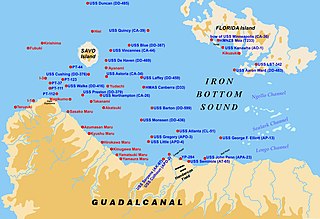
In the Solomon Islands, the waters between the Florida Islands and Taivu Point on the northeast of Guadalcanal are divided by reefs into Nggela Channel, Sealark Channel, and Lengo Channel. They connect Ironbottom Sound to the west with Indispensable Strait to the east.

In the Solomon Islands, the waters between the Florida Islands and Taivu Point on the northeast of Guadalcanal are divided by reefs into Nggela Channel, Sealark Channel and Lengo Channel. They connect Ironbottom Sound to the west with Indispensable Strait to the east.

Kuroshio was the third vessel to be commissioned in the 19-vessel Kagerō-class destroyers built for the Imperial Japanese Navy in the late-1930s under the Circle Three Supplementary Naval Expansion Program.
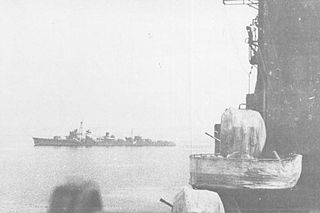
Oyashio was the fourth vessel to be commissioned in the 19-vessel Kagerō-class destroyers built for the Imperial Japanese Navy in the late 1930s under the Circle Three Supplementary Naval Expansion Program.
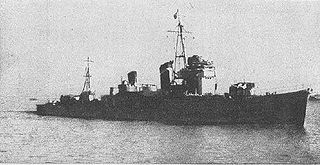
Kawakaze was the ninth of ten Shiratsuyu-class destroyers, and the third to be built for the Imperial Japanese Navy under the Circle Two Program. Completed in April of 1937, Kawakaze saw minor roles in the battles of the Java Sea, Eastern Solomans, Santa Cruz, and Guadalcanal, usually not doing much of note, but torpedoed and sank the destroyer USS Blue in the aftermath of the Battle of Savo Island, and came to her own in the Battle of Tassafaronga where she torpedoed and sank the heavy cruiser USS Northampton. Kawakaze was sunk by a mass torpedo attack from US destroyers at the Battle of Vella Gulf.

Suzukaze was the tenth and final vessel of ten Shiratsuyu-class destroyers, and the fourth to be built for the Imperial Japanese Navy under the Circle Two Program.

Takanami (高波) was a Yūgumo-class destroyer of the Imperial Japanese Navy. Her name means "Tall Wave".
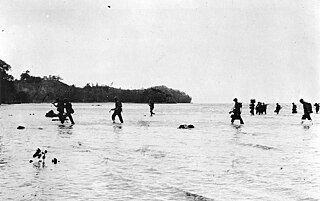
The Battle of Tulagi and Gavutu–Tanambogo was a land battle of the Pacific campaign of World War II, between the forces of the Imperial Japanese Navy and Allied ground forces. It took place 7–9 August 1942 on the Solomon Islands, during the initial Allied landings in the Guadalcanal campaign.
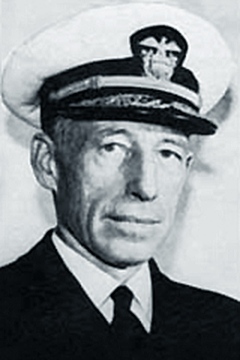
Carleton Herbert Wright was a rear admiral in the United States Navy (USN).

Tassafaronga Point is a point on the north shore of Guadalcanal, Solomon Islands. The Battle of Tassafaronga, one of several naval engagements fought in the waters north of the island during the World War II Guadalcanal Campaign, took its name from this point.


















